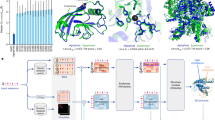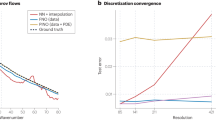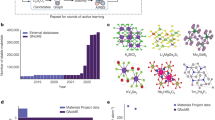Abstract
Modern methods of quantum mechanics have proved to be effective tools to understand and even predict materials properties. An essential element of the materials design process, relevant to both new materials and the optimization of existing ones, is knowing which crystal structures will form in an alloy system. Crystal structure can only be predicted effectively with quantum mechanics if an algorithm to direct the search through the large space of possible structures is found. We present a new approach to the prediction of structure that rigorously mines correlations embodied within experimental data and uses them to direct quantum mechanical techniques efficiently towards the stable crystal structure of materials.
This is a preview of subscription content, access via your institution
Access options
Subscribe to this journal
Receive 12 print issues and online access
$259.00 per year
only $21.58 per issue
Buy this article
- Purchase on Springer Link
- Instant access to full article PDF
Prices may be subject to local taxes which are calculated during checkout




Similar content being viewed by others
References
Olson, G. Designing a new material world. Science 288, 993–998 (2000).
Nye, J. F. Physical Properties of Crystals (Oxford Univ. Press, Oxford, 1985).
Wolverton, C., Yan, X.-Y., Vijayaraghavan, R. & Ozolinš, V. Incorporating first-principles energetics in computational thermodynamics approaches. Acta Mater. 50, 2187–2197 (2002).
Asta, M., Ozolinš, V. & Woodward, C. A first-principles approach to modeling alloy phase equilibria. J. Mater. 53, 16–19 (2001).
Curtarolo, S., Morgan, D. & Ceder, G. Accuracy of ab initio methods in predicting the crystal structures of metals: A review of 80 binary alloys. CALPHAD 29, 163–211 (2005).
Ceder, G. Predicting properties from scratch. Science 280, 1099–1100 (1998).
Pettifor, D. G. The structures of binary compounds: I. Phenomenological structure maps. J. Phys. C 19, 285–313 (1986).
Villars, P. A three-dimensional structural stability diagram for 998 binary AB intermetallic compounds. J. Less Common Met. 92, 215–238 (1983).
Morgan, D. & Ceder, G. in Handbook of Materials Modeling Vol. 1 (eds Catlow, R., Shercliff, H. & Yip, S.) 395–421 (Kluwer Academic, Dordrecht, 2005).
Morgan, D., Rodgers, J. & Ceder, G. Automatic construction, implementation and assessment of Pettifor maps. J. Phys. C 15, 4361–4369 (2003).
Russell, S. & Norvig, P. Artificial Intelligence: A Modern Approach (Prentice Hall, Upper Saddle River, 1995).
Morita, T. Cluster variation method of cooperative phenomena and its generalization I. J. Phys. Soc. Japan 12, 753–755 (1957).
Villars, P. The Pauling File Inorganic Materials Database and Design System—Binaries Edition (CD-ROM) (ASM International, Ohio, 2002).
Cover, T. M. & Thomas, J. A. Elements of Information Theory (Wiley, New York, 1991).
De Boer, F. R. Cohesion in Metals (North-Holland, Amsterdam, 1988).
Prokof'ev, M. V., Kolesnichenko, V. E. & Karonik, V. V. Composition and structure of alloys in the Mg-Ag system near Mg3Ag . Inorg. Mater. 21, 1168–1170 (1985).
Curtarolo, S., Morgan, D., Persson, K., Rodgers, J. & Ceder, G. Predicting crystal structures with data mining of quantum calculations. Phys. Rev. Lett. 91, 135503 (2003).
Stone, M. Cross-validatory choice and assessment of statistical predictions. J. R. Stat. Soc. B 36, 111–147 (1974).
Jaynes, E. T. Probability Theory: The Logic of Science (Cambridge Univ. Press, New York, 2003).
Cheeseman, P. & Stutz, J. in Advances in Knowledge Discovery and Data Mining (ed. Fayyad, U. M.et al.) 61–83 (AAAI Press, Menlo Park, California, 1996).
Blöchl, P. E. Projector augmented-wave method. Phys. Rev. B 50, 17953 (1994).
Kresse, G. & Furthmüller, J. Efficiency of ab-initio total energy calculations for metals and semiconductors using a plane-wave basis set. Comput. Mater. Sci. 6, 15–50 (1996).
Monkhorst, H. J. & Pack, J. D. Special points for Brillouin-zone integrations. Phys. Rev. B 13, 5188–5192 (1976).
Methfessel, M. & Paxton, A. T. High-precision sampling for Brillouin-zone integration in metals. Phys. Rev. B 40, 3616–3621 (1989).
Acknowledgements
This work was funded by NSF-ITR grant DMR-0312537, the Institute for Soldier Nanotechnologies (ISN) grant DAAD 19-02-D-0002, and the DOE, Office of Basic Energy Sciences under Contract No. DE-FG02-96ER45571. We would also like to acknowledge the National Science Foundation and the San Diego Supercomputer Center for additional computational resources.
Author information
Authors and Affiliations
Corresponding author
Ethics declarations
Competing interests
The authors declare no competing financial interests.
Rights and permissions
About this article
Cite this article
Fischer, C., Tibbetts, K., Morgan, D. et al. Predicting crystal structure by merging data mining with quantum mechanics. Nature Mater 5, 641–646 (2006). https://doi.org/10.1038/nmat1691
Received:
Accepted:
Published:
Issue Date:
DOI: https://doi.org/10.1038/nmat1691
This article is cited by
-
Advances in materials informatics: a review
Journal of Materials Science (2024)
-
A Continuous Action Space Tree search for INverse desiGn (CASTING) framework for materials discovery
npj Computational Materials (2023)
-
Accelerating the prediction of stable materials with machine learning
Nature Computational Science (2023)
-
Dataset of solution-based inorganic materials synthesis procedures extracted from the scientific literature
Scientific Data (2022)
-
Text-mined dataset of gold nanoparticle synthesis procedures, morphologies, and size entities
Scientific Data (2022)



